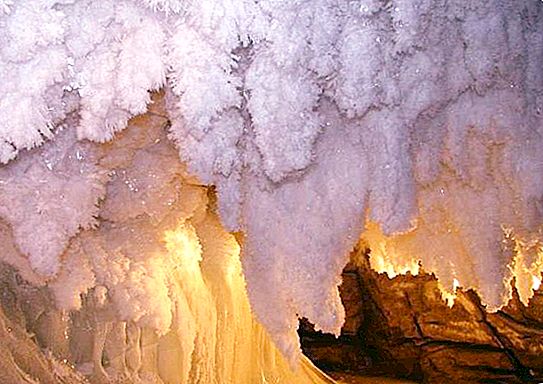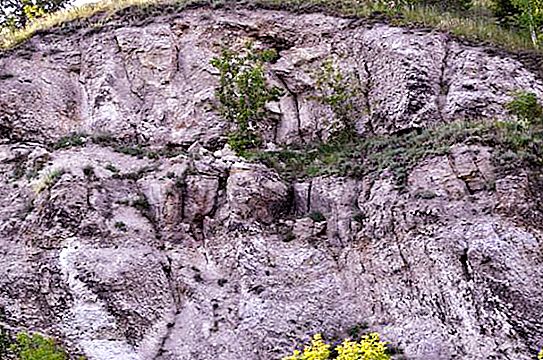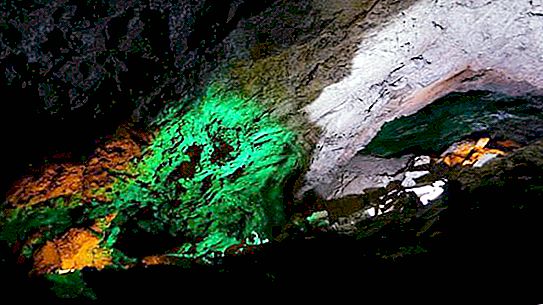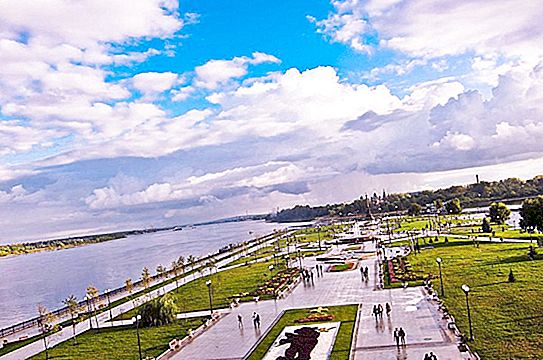Sometimes, in order to plunge headlong into the pristine splendor of nature, you do not need to go to the ends of the world. In her native country there are many wonderful places where she keeps for us her amazing beauty.
One of them is Ice Mountain with a Kungur cave, which hides underground lakes in its bowels, mysterious grottoes, ice blocks frozen in bizarre forms. Since 2001, they together constitute a historical and natural complex.

Location and description of Mount Icy
In the north-east of the city of Kungur in the Perm region is Mount Ledyanaya. Its height is small, just over 90 m above the bottoms of two rivers - Shakva and Sylva, the watershed between which it occupies. The mountain is a plateau-like hill, cut by karst formations in the form of round or conical funnels. Some have gentle slopes covered with turf, others have steep edges. The largest of them reach 15 m in depth and exceed 50 m across. Some funnels are filled with water and form karst lakes.
Sometimes pits up to 1 km wide are found on the surface, mostly shallow. There are a lot of karst dips, the vast majority of which do not exceed 5 m across, the rest - 10 m. Some are combined into group failures of different sizes. Karst formations are distributed unevenly: in places their density per 1 sq. Km. km reaches 3, 000 pieces, and there may not be a single one in the neighborhood. A large cluster of depressions is located in the Baidarashki tract, on the outskirts of the northwestern slope of the mountain. Karst funnels indented and its top. Ice Mountain is a unique geological object. This is the most visited tourist attraction.
Mountain vegetation
Mount Ledyanaya, where the variegation of vegetation and soil cover is explained by an extremely uneven topography, is listed as part of the Kungur island forest-steppe, in the subzone of southern taiga. The mountain range is covered with vegetation of three types: forest, meadow and steppe. Here plants are found that are uncharacteristic of the flora of the Perm Territory. The southern slope is covered with relic steppe and mountain-steppe plants, adapted to gypsum soil.
On its surface, silver strings of feathery feather grass are spread, and in mid-summer, blue mordovian balls bloom. Protected plant species are found on Icy Mountain: red pollen-headed, Thyme Talieva, monolithic sunflower, Danish astragalus and others. In this area it is forbidden to collect medicinal herbs, pick flowers, make fires.
Kungur cave
The Ice Mountain is closely connected with the pearl of the Urals hidden in its bowels - the Kungur ice cave, which breathes through organ pipes and funnels on its surface, and the steppe plants above grow thanks to easily permeable cave rocks. Formed 260 million years ago, they consist of gypsum and anhydrite with layers of dolomites and limestone. The rocks belong to the Permian period of the geological history of our planet.

The cave's uniqueness lies in its unusual appearance created by bizarre ice stalagmites and stalactites, numerous lakes and picturesque grottoes. The length of this kingdom of frozen ice and stone is almost 6 km, it is the seventh largest in the world, but, undoubtedly, the first in beauty.
According to scientists, the cave is at least 10 thousand years old. Over the past millennia, as a result of countless landslides, most of the arches in the grottoes assumed a domed shape. The cleanest air, galactic silence, the grandeur of the ice decoration make the Kungur cave a rare natural wonder. It is located low, only 120 m above sea level, therefore there are no mountain glaciers or permafrost, but there is a reference for caves microcirculation of air according to the type of furnace draft, which determines the features of the intra-cave climate.
Each year, ice sculptures change their shape under the influence of the temperature of the incoming air, the cave is constantly being transformed. In most central grottoes, due to the heat of the Earth, “eternal spring” reigns (+ 6 ° C). The surface temperature affects the state of ice in the cave: the lower it is, the more cold is stored inside.
From the history of cave development
Kungur cave has been known to people since ancient times. Who and when it was discovered is unknown. There is an assumption that the Ice Mountain served as a winter camp for the Yermak squad in 1578, before his trip to Siberia. Now on top is Ermakovo settlement - an archaeological site.
The first scientific information about the Kungur cave was collected by Semyon Remezov in 1703. He made her plan. Later it was studied and described by many travelers and geographers, scientists, so in Russia it is the most explored cave. Its first keeper was Alexander Khlebnikov, an enthusiast and romantic, a patriot who devoted his life to the cave. Since 1914 and for almost 40 years, he studied the cave, equipped, led numerous excursions. Currently, the main tourist route is electrified. The skillfully illuminated cave looks simply magical.






